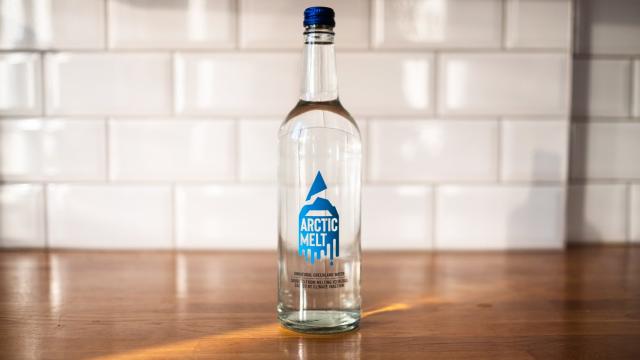I spend an uncomfortable amount of my life thinking about the death of the Arctic. Whether it’s covering studies, writing about the tundra exploding, or trying to find the perfect photo to illustrate a story on the sudden meltdown of the Greenland ice sheet, the Arctic is a large part of my professional life.
Yet for all the coverage, I have had zero contact with the world above 66 degrees north, the latitude of the Arctic Circle. That is, until last week when I was given a bottle of Greenland meltwater while attending United Nations climate talks in Glasgow.
The water was brought to the talks courtesy of Arctic Basecamp, a group of scientists that wants to raise awareness about the collapse of the Arctic, which heating up nearly three times faster than the rest of the world. Being given a bottle of water from Greenland, which is basically suffering the planetary equivalent of flesh-eating disease, is a strange feeling. It is, quite literally, liquid death. (Apologies to Liquid Death.)
Yet bottled water is also a ubiquitous facet of American life, with industry numbers showing the country consuming an astounding 15 billion gallons of it in 2020 alone. The bottled water options in a given bodega are manifold, to say nothing of the choices in more upscale markets or what you’d find on the water menu put together by the country’s only water sommelier.
With these two tensions, I did what any average American slash climate journalist would do. I tossed the water — which was put in glass bottles in Scotland, making it less environmentally damaging as a result — in the fridge for a day then cracked it open to taste the end of the world. Watching the water glug out of the bottle harkened back to what was happening at a much larger scale in Greenland.
There, ice melt has accelerated and is now six times faster than it was in 1980. Large scale meltdowns have hit the ice sheet in recent years and bizarre rain fell for the first time in recorded history at the top of the ice sheet that’s nearly 3 kilometres above sea level. The ice sheet is also draining through holes in the surface, and, well, the list goes on. The point is, what was once solid is increasingly liquid. And here I was watching the end result pour into a glass. (Technically two glasses since intrepid Earther reporter Molly Taft joined me on this journey to the Arctic via bottled water.)

With the water finished glugging out of the bottle, I tipped the glass now ringed in condensation to my lips. I don’t know what I was expecting. Maybe a hint of grit from the soot ending up on the ice sheet courtesy of massive wildfires. A kiss of salt from where glaciers meet the North Atlantic. Or perhaps I’d be knocked off-kilter given how ice melt is altering the crust of the planet.
Instead, I tasted nothing. It was almost like distilled water. No fore- or aftertaste. Just a slosh of crisp liquid and then emptiness, my slightly chilled teeth the only sign I had even taken a sip.
Arctic Basecamp’s water comes with a tag and campaign demanding world leaders cut emissions in half by the end of this decade. That would put the world on track to cap global warming to 1.5 degrees Celsius. (Other estimates have called even steeper cuts.) The campaign also points out that 17 million bottles of water just like the now half-empty one sitting on the counter were pouring into the ocean every second.
It felt visceral holding the consequences of a century-plus of unabated burning of fossil fuels, to be able to raise a glass. And yet the lack of taste and watching every country just days later agree to a watered-down climate pact felt a little anticlimactic.
I’ve had the pleasure (“pleasure”) of drinking another climate-inspired concoction, Fat Tire’s Scorched Earth beer of the future. The beer was made using drought-resistant grains, acerbic dandelions, and smoked malts to mimic wildfire-tinged water. Tasting the acrid future of failure was a gut punch. With the cold, hard death of the Arctic swishing around in my mouth and the state of climate talks, though, I couldn’t stop thinking about how more is still needed to stop the planet from falling off a cliff — or more accurately, being pushed off.
